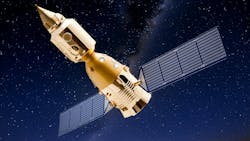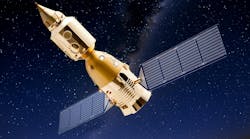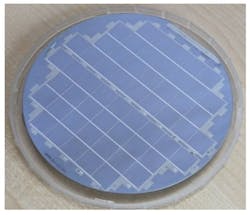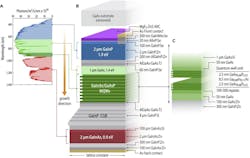Pushing the Power Density in Outer Space Systems
What you’ll learn:
- Why outer space systems need high power density.
- Why power-generation systems in outer space are important.
Generating electricity at nighttime using renewable resources has become extremely important since a billion people on Earth are living off some electric grid. With no solar power at night, users may instead employ the coldness of the universe as a thermodynamic resource.
Specifically, users will be able to use a heat engine that can extract energy using the temperature gradient between the ambient environment maintained close to 300 K and outer space steady at approximately 3 K. Such a method will enable efficient dumping of excessive heat from the heat engine output through a stable low-temperature cold sink, namely outer space.
On this front, the first article in the References listed below presents an efficient optimization of a nighttime thermoelectric power generation system using radiative cooling. The authors demonstrate an electrical power density greater than 2 W/m2—it’s two orders of magnitude higher than previous works and is achievable using existing technology.
Even though this demonstration of nighttime electrical power generation is amazing, the confirmed power density is quite low. Achieving a power density at a 1 W/m2 level is key to fulfilling the energy demand of innumerable applications.
>>Download the PDF of this article, and check out the Library Series for similar articles
Designers can improve power generation by taking on these two challenges:
- The emitter simply needs to absorb heat power at frequencies/angles where the atmospheric emission is low, while a simple blackbody emitter2 absorbs heat power strongly at all frequencies and angles.
- The thermal design should mitigate the excessive parasitic heat loss that’s detrimental to forming thermoelectric current.2
The proposed system (Fig. 1) allows for optimal power generation at nighttime. It combines radiative cooling and thermoelectric power generation and can operate at night when solar energy harvesting isn’t available. The system delivers a power density of more than 2 W/m2. That’s two orders of magnitude higher than any previously reported experimental result achieved using existing technologies.
The thermoelectric power generator (TEG) occupies less than 1% of the system area footprint when achieving optimal power generation. The importance of the optimal emitter becomes clear with the gain of 153% in power density as compared to regular blackbody emitters.
Space Applications Under Development
It’s important to examine the quality of the whole manufacturing process in a significant number of devices—tens of 1-cm2 solar cells are defined by photolithography and tested (Fig. 2). Larger cell sizes, relevant to space applications, are under development.
For instance, there’s the triple-junction inverted metamorphic multijunction (IMM) structure, which includes quantum wells (QWs) in the middle sub cell. In Figure 3, layer thicknesses are shown for the global device, while the space device is slightly modified.
Another application—the electrical power system (EPS) in spacecraft—provides electrical power to all vehicle loads and is vital for the safe completion of NASA-defined missions. The EPS encompasses electrical power generation, distribution, and storage. The EPS is also a major fundamental subsystem and comprises a large portion of volume and mass in any kind of spacecraft.
When it comes to CubeSats, for example, the most commonly used architectures are battery-only or solar array/battery configurations. In these cases, batteries must be treated as potential hazards, because they sometimes combine stored energy with their caustic materials in the spacecraft.
Summary
High power density, in outer space systems, enhances many types of space-related applications. Spacecraft must rely on robust power systems to handle the challenges of deep space missions. Thus, reliable power-management and storage technologies are crucial for any mission success.
References
1. “Design of Nighttime Power Generation System to Optimally Utilize Outer Space Darkness,” Lingling Fan, Wei Li, Weiliang Jin, Shanhui Fan, Meir Orenstein; Department of Electrical Engineering, Ginzton Laboratory, Stanford University, Stanford, California 94305, USA; Department of Electrical Engineering, Technion-Israel Institute of Technology, 32000 Haifa, Israel, [email protected], [email protected], CLEO 2021 © OSA 2021.
2. “Generating light from darkness,” Aaswath P. Raman, Wei Li, and Shanhui Fan, Joule, 3(11):2679– 2686, 2019.
3. “Advances in Flexible and Lightweight 3J Space Solar Cells for High Power Density Applications,” Carlos Algora, Iván García, Pablo F. Palacios, Daniel Gómez-Reboreda, Pablo Martín, Clara Sanchez-Perez, Luis Cifuentes, Iván Lombardero, Mercedes Gabás, Ignacio Rey-Stolle, 2023 13th European Space Power Conference (ESPC), Instituto de Energía Solar, Universidad Politécnica de Madrid, Madrid, Spain, 2023.
4. “Solar Energy in Space Applications: Review and Technology Perspectives,” Rosaria Verduci, Valentino Romano, Giuseppe Brunetti, Narges Yaghoobi Nia, Aldo Di Carlo, Giovanna D’Angelo, and Caterina Ciminelli, Advanced Energy Materials, 2022.
5. “Triple-junction solar cells with 39.5% terrestrial and 34.2% space efficiency enabled via thick quantum well superlattices,” Ryan M. France, John F. Geisz, Tao Song, Waldo Olavarria, Michelle Young, Alan Kibbler, and Myles A. Steiner, National Renewable Energy Laboratory, May 2022.
6. “Vacuum Evaporated All-Inorganic Perovskite Top Cell for Monolithic Perovskite/Perovskite/Silicon Triple-Junction Solar Cell,” Yashika Gupta, Minasadat Heydarian, Maryamsadat Heydarian, Patricia S. C. Schulze, Juliane Borchert, Fraunhofer Institute for Solar Energy Systems ISE, Freiburg im Breisgau, Germany, 2024 IEEE 52nd Photovoltaic Specialist Conference (PVSC), 978-1-6654-6426-0/24/©2024 IEEE, DOI: 10.1109/PVSC57443.2024.10748856, INATECH, University of Freiburg, Freiburg im Breisgau, Germany.
7. “Power density optimization for micro thermoelectric generators,” Kenneth E. Goodson, Marc T. Dunham, Michael T. Barako, Mehdi Asheghi, Department of Mechanical Engineering, Stanford University; Saniya LeBlanc, Department of Mechanical Engineering, The George Washington University; Baoxing Chen, Analog Devices Inc.
>>Download the PDF of this article, and check out the Library Series for similar articles
About the Author

Steve Taranovich
Freelance Technical Writer, Phoenix Information Communication LLC
Steve is a contributing editor to Electronic Design.
Author of the non-fiction “Guardians of the Right Stuff,” a true story of the Apollo program as told by NASA and Grumman Corp. engineers, an astronaut, and technicians.
Experienced Editor-In-Chief of EETimes/Planet Analog and Senior Technical Editor at EDN running the Analog and Power Management Design Centers from 2012 to 2019.
A demonstrated history in electronic circuit design and applications for 40 years, and nine years of technical writing and editing in industry. Skilled in Analog Electronics, Space-related Electronics, Audio, RF & Communications, Power Management, Electrical Engineering, and Integrated Circuits (IC).
1972 to 1988 worked as a circuit design engineer in audio (8 years) and microwave (8 years). Then was Corporate Account Manager/applications engineer for Burr-Brown from 1988 to 2000 when TI purchased Burr-Brown. Worked for TI from 2000 to 2011.
Strong media and communication professional with a BEEE from NYU Engineering in 1972 and an MSEE from Polytechnic University in 1989. Senior Lifetime member of IEEE. Former IEEE Long Island, NY Director of Educational Activities. Eta Kappa Nu EE honor society member since 1970.





